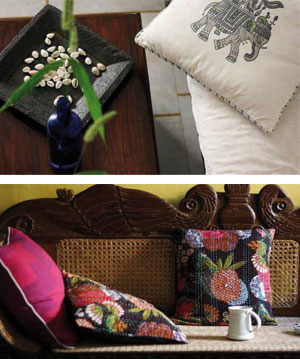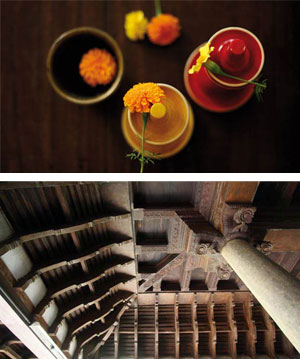Creating an eco-friendly home enables us to live in sync with our surroundings. It encompasses using environmentally-friendly products as well as being respectful of the natural eco-systems in the vicinity. With a growing need to protect our planet, an increasing number of people are opting for ‘green’ homes. But then, building eco-friendly homes from scratch is not easy. Your home should depict your personality through its style of architecture, while incorporating materials that have been least industrially processed. But care must also be taken to ensure that it doesn’t jar with the local architecture; it must be climatically relevant too. Creating an eco-friendly living-space is a craft of love, not a snobbish attempt to show off your engineering prowess.
Here are a few environmentally-friendly strategies to keep in mind when you decide to make your home eco-friendly:
Building material
Modern building materials like steel, glass or cement are manufactured by using ‘high embodied energy’. These materials may cost less, but consume a great amount of fuel during manufacturing. Houses built using contemporary materials consume large amounts of energy during their production and also for their maintenance. They absorb a lot of heat, making the house hot and uncomfortable. To cool the area down, you have to keep an air-conditioner or a fan on continuously, leading to a high electricity bill. Such architecture proves to be expensive in the long run. So wherever you can, try to use stones, bricks or wood for the walls. They are eco-friendly and have a charm of their own.
“Bricks to me are like faces” said the great architect Laurie Baker. “All of them are made of burnt mud, but they vary slightly in shape and colour. I think these small variations give tremendous character to a wall made of thousands of bricks, so I never dream of covering such a unique and distinctive creation with plaster, which is mainly dull and characterless. I like the contrast of textures of brick, of stone, of concrete, of wood.”

Energy
Though expensive to install, a solar panel is a must-have in any eco-friendly home because it harnesses and effectively utilises natural energy. Whenever you can, opt for renewable sources of energy.
Lighting
Houses should be oriented in the direction that yields the highest amount of sunlight and breeze. Design your windows such that you can make the maximum use of natural light. This leads to enormous energy and cost savings. You can also reduce your consumption of electricity by using energy-efficient lighting like LED lamps and power-saving home appliances; these lamps also last longer. Avoid CFL bulbs as they contain mercury, which is a dangerous heavy metal; hence pay attention to how you dispose of those bulbs.
Waste management
How you want to manage your solid waste should be planned before the construction of your home starts. Water needs to be harnessed through conservation, harvesting and recycling. A lot of water can be conserved by integrating paving areas to manage the storm-water runoffs and to harvest the rain water. Underground tanks can also be built for harvesting rainwater, which could lessen water shortage during summers, reclaiming this water through the selective membrane process will make you self-sufficient.
Flooring
Tiled floors using materials like terracota, clay, laminate, wood, athangudi is the usual preference. However, there are other new additions to flooring options. Linoleum sheets produced from linseed oil, wood-flour and cork are durable, fire-retardant and water-resistant. These sheets are pressed onto the sub-floor [usually tiles]. The joints are then welded, to make them dirt-free and peel-proof. Linoleum being naturally anti-bacterial and biodegradable makes it one of the best choices for creating an eco-friendly floor.
Bamboo is another sustainable material currently being used for flooring. Bamboo shoots are pressed to fabricate sections and when installed they resemble hardwood flooring. These floors can be maintained by vacuuming and wet mopping.
Carpeted floors are cosy and they provide thermal insulation during winters. Carpets are available in synthetic and natural fibres. Synthetic fibres like rayon, nylon, polyester etc. are usually preferred, since they are affordable, long lasting and recyclable. Natural fibres such as jute, coir, wool, hemp are usually tufted to form carpets; they ensure a healthy indoor environment by using safe and recyclable materials and low Volatile Organic Compounds [VOC] adhesive.
Poly Lactic Acid [PLA] fibres spun from polymers obtained from starch-based agricultural products such as corn, rice and sugar beet are environment friendly and decompose into lactic acid, which replenishes the soil when buried. They are made by a process that uses less fuel and consumes less water.

Roofs
Eco-friendly ceilings can vary from filler slabs to Mangalore-tiled roofs, mud-packed roofs, thatched roofs or brick domes. Lightweight and inexpensive materials such as low-grade Mangalore tiles, coconut shells, glass bottles, etc. are used as materials in filler slabs. This roofing costs 30 – 35 per cent less than conventional concrete roofing, which helps you save a considerable amount. This has a cooling effect and has no health hazards as opposed to galvanised iron sheets and asbestos cement sheet roofs, which dissipate too much heat and are known to increase the risk of diseases such as lung cancer. Recycled shingles are among the most popular—and perhaps the ‘greenest’—of all roofing products. They are made from recycled waste materials like plastic, rubber or wood fibre.
You can manage the microclimate too through appropriate landscaping. This includes the setting up of a rooftop garden and, if space is not a constraint, you can even create a vegetable garden in the front or back of your house.
Doors and windows
Doors that are made from recycled or old wood could be used if it suits the design style of your home. All wooden items can be polished using cashew nut oil. Terracotta jaalis and cement jaalis can also be used in place of windows, which allow more ventilation. Staircases could also be made using old wood.
Make your doors and windows from glasses that are designed to reflect heat and give the room insulation. These will keep the rooms warm during cold winters and will reflect unwanted heat during summers. This not only sets the right ambience, but also fills the interiors with natural light. In the long term, this will also save you a lot of money that you would have otherwise spent on heating or cooling the rooms.
Finishes
Paints are mandatory in most homes, but are also a major cause of indoor air pollution. Many paints contain VOCs, which are hazardous to health. Some of these compounds react with the nitrogen-oxide in the air in the presence of sunlight, forming a chemical compound, which causes respiratory problems. Paints that have low VOC content use water as a carrier and contain very little or no metal and formaldehyde. Paints are safest if made from natural ingredients such as water, clay, plant dyes, oils, resins, clay, calcium, chalk, talcum, beeswax and natural latex.
Furniture, textiles and décor items
Furniture can always be recycled and reused. Old wood can be used to make new contemporary furniture or you can simply buy antique furniture for your home. Tyres are recycled to make furniture, photo frames and a variety of other products. Many NGOs sell home furnishings made from recycled material.
Recycled news paper can be used to make curtains, waste paper baskets, breadbaskets and bowls.
The versatile bamboo is used for making a wide range of products like furniture, jewellery, mats, coasters, trays, beads, runners and chataais. Natural fibre grasses are also used to make varying décor items and furniture. Eco-friendly textiles like khadi, mulul, cotton, blockprints, ikat etc. are available to make your upholstery. Each region in India has a unique textile and you can explore them according to your interests.
Once you have decided to take the road to building your eco-friendly home, you will love the feeling of having done your bit for the planet.
This was first published in the October 2014 issue of Complete Wellbeing.

